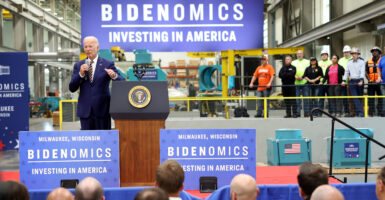Is America really in a manufacturing renaissance? Far from it. U.S. manufacturing is hemorrhaging, and the numbers the Biden administration uses to claim otherwise are bought.
Rather than address the problem, the White House is playing shell games with the economic data to gaslight Americans.
It turns out that the manufacturing boom is manufactured, with your tax dollars fueling the furnace.
Under President Joe Biden, government spending has increased by trillions of dollars, including hundreds of billions in manufacturing subsidies for politically favored industries, such as green energy. This has artificially boosted key numbers like gross domestic product and construction spending in the manufacturing sector.
But, going by the history of political handouts, many of the new factories and facilities being built are not going to produce anything that consumers want, wasting resources that could have been used to truly build up our manufacturing base.
Instead, billions of dollars in subsidies for green energy projects are financing the building of factories that will produce things like inefficient solar panels, which cannot turn a profit.
And thanks to Biden’s deceptively named Inflation Reduction Act, taxpayers will be left holding the bag when those projects fail, since taxpayers are on the hook for the loans used to finance these projects, including loans to Chinese companies.
The breakneck pace of construction in the manufacturing sector merely papers over myriad warning signs.
Surveys conducted by the regional Federal Reserve banks show a slowdown in manufacturing, with many showing the industry outright contracting. The Philadelphia and New York surveys have seen some of the fastest contractions on record in Biden’s presidency, rivaling those logged with initial pandemic-era lockdowns and in the aftermath of the 9/11 terrorist attacks.
Before the pandemic, manufacturing was truly booming: Output, optimism, and employment were rising. Under Biden, however, these metrics have remained depressed.
For most of the last year, several purchasing manager indexes have signaled a contraction in the sector. Meanwhile, both industrial production and the percentage of factory capacity being used have been zigzagging down since last September. Total factory output has declined for the past four months.
It should be no surprise then that manufacturers have stopped hiring. Employment in the sector is exactly the same as it was six months ago.
These facts help explain why Americans have such a negative view of the economy—and manufacturing in particular—despite the White House buying friends.
Biden’s bloated subsidies for manufacturing are like painkillers masking the symptoms of cancer. The doctor can claim that the patient is feeling better, but the treatment merely hides the underlying condition while the cancer grows worse.
The true irony is that “Bidenomics” has been a key reason for manufacturing’s difficulties. As Biden borrowed, printed, and spent trillions of dollars, it crowded out private investment, above all in manufacturing.
A key economic indicator, real private fixed investment, is now the same as when he took office—almost three lost years.
Meanwhile, the historic inflation arising from the wasteful pumping of trillions of dollars into the economy has increased borrowing costs, strangling financing for legitimate manufacturing projects. The highest interest rates in decades have been yet another anchor around the neck of manufacturers.
All of this is troubling because when manufacturing falls, the rest of the economy tends to fall into recession. The current contraction in the manufacturing sector, even if Biden covers it up, is a bad omen for the nation.
The White House must put politics aside, stop playing numbers games, and reverse course on its disastrous economic policies while there’s still a manufacturing sector to save.
Originally published at WashingtonTimes.com
Have an opinion about this article? To sound off, please email letters@DailySignal.com and we’ll consider publishing your edited remarks in our regular “We Hear You” feature. Remember to include the url or headline of the article plus your name and town and/or state.

























